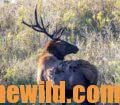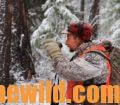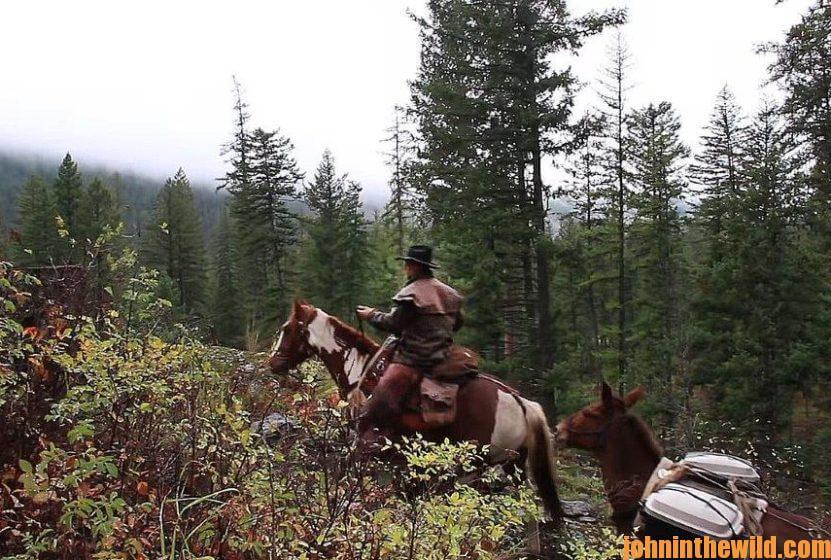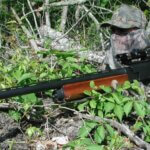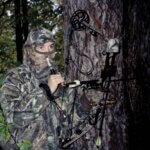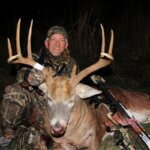Editor’s Note: Shawn Fulton has been guiding for elk for 12 years and currently guides and outfits for Spotted Bear Ranch (http://www.spottedbear.com/) in northwest Montana, just south of Glacier National Park.
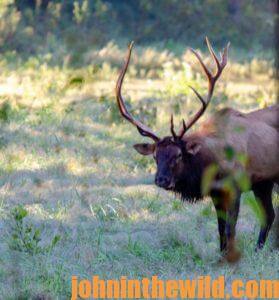 * The Sleeping Bull
* The Sleeping Bull
On the first elk hunt I went on without a client, I had two tags in my pocket, one for elk and one for mule deer, so that was exciting. I was hunting elk on public lands I never had hunted previously. A buddy of mine Pat, had scouted this property using maps and the internet to try and learn places where chances might be best to take elk. We found a road that went to the top of a ridge made up of land that was pretty sketchy and rough. When we started up the road, we could tell this intense terrain was steep and would be hard to hunt. About halfway up the mountain, snow started falling, and we realized a storm front was moving off the mountains. However, these conditions were often the best to see elk moving. We’d hunted under those conditions plenty of the times in the past. So, we had no problem continuing to drive up that rocky road.
Once we reached the top of the ridgeline on our first afternoon, we noticed that the ridgeline dropped off into the head of a drainage. After moving about 200-yards down the ridgeline, we split off. My buddy went to one side of the ridge, and I went to the other. In the spring and the summer, cattle grazed on these lands we were hunting, creating trails elk used later. As the general elk season got closer, the ranchers who owned the cattle moved them back down to the lower lands. The elk then used those cattle trails to navigate through the mountains and the drainages.
As I started stalking down one of those cattle trails, I spotted the yellow and white of a bull’s rump, bedded-down less than 100-yards away. I hadn’t been out of the truck for more than about two hours. I moved a little closer to the bull and found a rest to brace my rifle on before I took a shot. Everything was perfect that day. The wind was in my face, blowing from the elk toward me. We’d checked the wind when we left the truck, and I continued to study the wind as I moved from the ridgeline. As a guide, I’d learned the importance of checking the wind’s direction continuously to make sure the wind was in my face, so the elk wouldn’t smell me. If the wind changed, I’d stop and see if the wind would switch again. If not, I’d back out of that spot and make a circle around to hunt with the wind in my face. I’d learned before when elk hunting that you always lost with a bad wind.
When I saw that sleeping bull, I thought to myself, “Wow! This is gonna work. I’m gonna have an opportunity to take my first bull.” That bull was on his back, looking away. I was close enough to see the bull’s spine and both of his shoulder blades. I aimed for the center of his spine, knowing that the bullet would travel down through the heart and lung area. Once I fired, the bull dropped his head and died where he was. I was shooting a .300 Win Mag (https://winchester.com/).
As soon as I shot the bull, I knew the fun was over, and the work was about to begin. However, I realized that gutting, caping and quartering the elk wouldn’t be as difficult as it could be because Pat, my hunting buddy, would find me and help me get my bull out. No more than 20 minutes after Pat and I had separated on the top of the mountain, I’d shot the bull elk. By the time I got my hands on the elk and checked out where my bullet had hit, Pat was already by my side at my elk.
 One of the significant advantages you have when you hunt with a partner is you’ll have help getting your elk out, if you’re successful. Then you can hunt with him and get his animal out of the mountain if he’s successful. After we got my elk back to camp, we hunted two more days together, and Pat took a cow elk. We selected this area to hunt because we could take a bull elk, a cow elk and a mule deer there. Since we had only one week to hunt, we felt like the more tags we had, the better our chances were for taking an animal.
One of the significant advantages you have when you hunt with a partner is you’ll have help getting your elk out, if you’re successful. Then you can hunt with him and get his animal out of the mountain if he’s successful. After we got my elk back to camp, we hunted two more days together, and Pat took a cow elk. We selected this area to hunt because we could take a bull elk, a cow elk and a mule deer there. Since we had only one week to hunt, we felt like the more tags we had, the better our chances were for taking an animal.
* The Mountain Sliding Elk:
Some years later, I decided to return to that same unit where I’d taken my first bull – the sleeping bull. However, when we got to the sketchy road, there was no way we could go up it. So, we came into the same unit from a different direction, due to the snow, and went as far as we could with the truck up the mountain. Then we had a long hike to reach the top of the hill. Bryan, my friend who went with me on this hunt moved to one side of the mountain, and I went to the other side. Bryan had taken a mule deer on the second day, but I hadn’t seen a mule deer or an elk until the fifth day of the hunt. We’d chosen to go to this area because I’d spotted plenty of elk two years before when taking my first elk in this unit.
On the fourth night, when I was driving out of the mountains to return to the hotel, I spotted a large herd of elk. I stopped to glass the face of the mountain at last light and decided I’d hunt that side of the mountain the next morning. I’d spotted a couple of nice bulls, so I felt good about my chances of taking an elk then.
On the last morning of the hunt, I reached the mountain early and hiked for 1-1/2 hours in the dark to reach the place where I wanted to start hunting. Once I finally got to the ridgeline where I wanted to hunt, the sun was beginning to peep over the ridgeline. I spotted two other hunters down below me, moving toward the herd of elk I’d identified with my binoculars the evening before. Just as I saw the hunters, I heard three or four rifle shots, realized they’d taken some bulls and then saw three or more bulls running up the mountains, going to the drainage I’d planned to hunt. Realizing those bulls already had been shot at, I knew I didn’t have a chance to catch up to them that day. So, I changed my plans from going elk hunting the rest of the day to hunting mule deer.
I started climbing up the mountain and kept on climbing, searching for mule deer. Then I came across some elk tracks that I assumed might be the bulls I’d seen the night before. Studying the elk tracks, I noticed that the tracks weren’t far apart, and apparently, the elk had been walking, not running. I moved slowly, following the tracks. I changed my mindset from hunting mule deer back to hunting elk. After following the tracks, the tracks split up, and I could see that the elk had gone in three different directions.
The snow on top of the mountain was about knee-deep, so I had to move slowly. I also noticed that the snow wasn’t crested over and didn’t crack on top of my feet, and I could move almost silently. Next, I saw white-and-yellow butts of three bull elk bedded-down together about 40-yards from me, facing away from me. The only shot I had was at the back of one bull’s head. I found a brace to prop my gun on, aimed for the back of the biggest bull’s head and squeezed the trigger. The bullet went right through the base of the bull’s head and came out his lower jaw. He was a 5×5 bull, scoring less than 300 inches. However, this day was the last day of my hunt, and I’m more of a meat hunter than a trophy hunter, so I took him.
As I mentioned earlier, we had knee-deep to thigh-deep snow. I field dressed the bull and decided that as much snow as we had, I could slide that bull off the mountain. I was almost to the top of the mountain that was at about 10,000 feet and estimated I was at 8,200 feet elevation. As I slid the bull down the mountain, several times, the bull slid faster than I was pulling him, and he nearly ran over me a couple of times. When I finally got the bull to the bottom of the mountain, I realized I had about a 2-mile hike to meet my buddy Bryan. I opted to leave the bull at the bottom of the hill overnight, knowing few predators were in that place. I planned hike back to the truck and return the next morning with Bryan, quarter the bull and carry him out. The following morning we used an otter snow sled we could pull. Once we got the elk quartered, we put the meat in the sled and pulled him back to the truck. This area was pretty much west of Yellowstone National Forest.
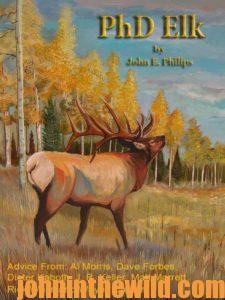
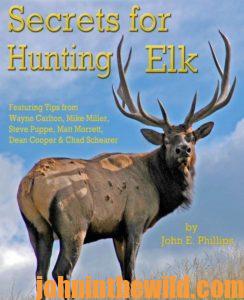 To learn more about elk hunting, check out John E. Phillips’ books, “PhD Elk: How to Hunt the Smartest Elk in Any State” and “Secrets for Hunting Elk,” both available at
To learn more about elk hunting, check out John E. Phillips’ books, “PhD Elk: How to Hunt the Smartest Elk in Any State” and “Secrets for Hunting Elk,” both available at
http://amzn.to/WkbAWa and http://amzn.to/WGb9le. You may have to copy and paste these clicks into your browser. (When you click on these books, notice on the left where Amazon allows you to read 10% of the books for free).
Tomorrow: Shawn Fulton Becomes an Elk Guide and Outfitter

